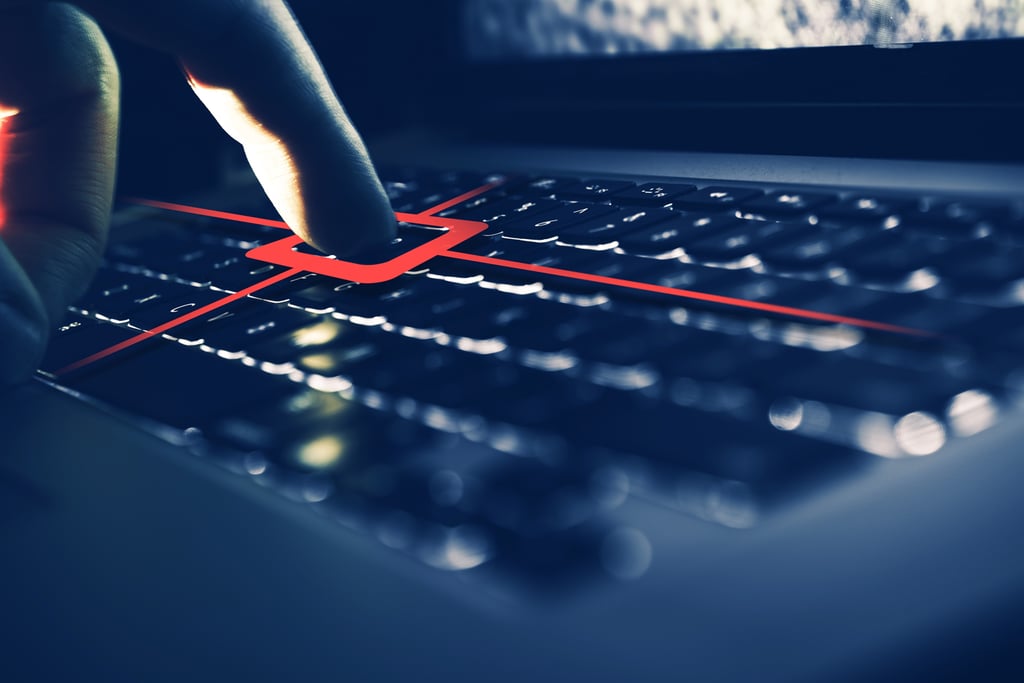
Index finger pressing a key on laptop keyboard with a targeting reticle.
Learn what keyloggers are and how to secure the information you type into your device daily.

A keystroke logger, also known as a keylogger, is a software program or hardware device that logs and records every keystroke input on a computer. Bad actors can use it to steal sensitive data like passwords, financial information, and other confidential information. Keyloggers can also be used legitimately by parents to monitor their kids’ online activities, and employers can use them to track employees’ computer usage.
Keyloggers can be broken down into two distinct definitions:
In addition to recording keystrokes, keylogger software can also collect user data through other methods, such as capturing screenshots, recording web searches and visits, and monitoring clipboard activity.
Keyloggers are either hardware-based or software-based.
Hardware keyloggers are physical devices used to monitor and record a user’s activity on a computer. These devices are plugged into the back of a computer keyboard and have their own internal memory. The data is recorded directly to the device’s memory and can be retrieved later by the attacker.
Hardware keyloggers are more difficult to detect than software keyloggers, as they are hardly visible on the computer’s system. To prevent hardware keyloggers from being installed, physically inspect your computer’s ports and cables periodically for any suspicious devices that may have been installed without your knowledge.
A software keylogger is a type of monitoring and tracking software that logs keystrokes from a computer keyboard. These keystrokes are recorded and stored in an encrypted log file that the attacker can access remotely.
Software keyloggers can be disseminated when you click on malicious links, download malware, visit a website with dangerous code, or open files that have been infected with malware. Although more easily detectable than hardware keyloggers, software-based keyloggers can be installed remotely, without needing physical access to your system.
Hardware-based and software-based keyloggers work differently. Generally, both types of keyloggers track and record every keystroke made on a computer based on a predefined command. These commands include:
In the case of hardware keyloggers, a physical device is plugged into a computer’s keyboard connection and records every keystroke that is entered into the keyboard. These keyloggers require physical access to a computer in order to be installed and are usually undetectable because computer users rarely pay attention to devices plugged into the backside of the computer.
On the other hand, software keyloggers are programs installed on the user’s computer and run invisibly in the background. They include two files that are installed in the same directory: a dynamic link library (DLL) and an executable file. The DLL file will monitor the system and record keystrokes into a file, while the executable file is responsible for launching the keylogger when the computer is turned on.
There are two major types of software keyloggers:
User-mode keyloggers work by hooking onto an existing Windows application programming interface (API) to intercept keystrokes and mouse movement. This type of keylogger can be detected easily because they are documented WIN32 APIs.
Kernel-mode keyloggers are more complex than user-mode variants; they are placed inside the computer’s operating system (OS) core, making them more difficult to detect and remove. They use filter drivers to capture keyboard strokes and can also run in stealth modes.
Phishing emails often contain malicious links or attachments that can install keyloggers on your computer or mobile device. Be cautious of emails from unknown senders or that contain suspicious content. Keyloggers can be hidden in programs or apps that you download from the internet, so it’s important to download software from trusted sources.
Software updates often include security patches that address vulnerabilities that could be exploited by keyloggers. Make sure your OS, web browser, and other software are up-to-date.
Firewalls and antivirus protection can help protect your computer from malicious software such as keyloggers. Ensure you keep them up-to-date so they can detect the latest threats.
Use unique and strong passwords for each of your accounts. Don’t use the same password for different services. Strong passwords that are difficult to guess can help prevent attackers from accessing your accounts. Include uppercase and lowercase letters, numbers, and symbols in your passwords and avoid using easily guessable information like your name or birthdate.
If you find or suspect that a keylogger has compromised your system, here are the steps you can follow to detect and remove it.
Here are the answers to a few commonly asked questions about keyloggers.
Several warning signs may indicate the presence of a keylogger on your device. One of the most common signs is a slow browser; the keylogger may use significant system resources to record keystrokes and send data to the attacker, thereby reducing system speed.
A mouse movement lag or keystroke pause can also mean your system has been infected. The keylogger may be intercepting and recording these inputs before passing them to the OS. Additionally, if your cursor disappears or behaves strangely, it may indicate that a keylogger is actively manipulating your device.
Make sure to run a comprehensive system scan to be certain and take corrective measures to fix the issues.
Yes. Although keyloggers are primarily created to record and log all keystrokes a user makes on a device, some advanced keyloggers can take screenshots of your screen and capture clipboard text in addition to logging keystrokes.
Regardless of the type of keylogger (hardware- or software-based), they are a threat to both enterprises’ and individuals’ security infrastructure when used maliciously. Legitimate users should seek consent before using a keylogger, even for legal and legitimate reasons like monitoring employees or children.
Aside from keyloggers, other malicious programs such as trojans, rootkits, spyware, ransomware, and viruses can also be used to collect personal data from unsuspecting victims. Anti-malware programs with real-time protection capabilities must be installed on all systems in order to prevent these types of cyber threats.
Here are the best enterprise network security companies to protect your company’s data.

Aminu Abdullahi is an experienced B2B technology and finance writer and award-winning public speaker. He is the co-author of the e-book, The Ultimate Creativity Playbook, and has written for various publications, including eWEEK, Enterprise Networking Planet, Tech Republic, eSecurity Planet, CIO Insight, Enterprise Storage Forum, IT Business Edge, Webopedia, Software Pundit, and Geekflare.

Enterprise Networking Planet aims to educate and assist IT administrators in building strong network infrastructures for their enterprise companies. Enterprise Networking Planet contributors write about relevant and useful topics on the cutting edge of enterprise networking based on years of personal experience in the field.
Property of TechnologyAdvice. © 2025 TechnologyAdvice. All Rights Reserved
Advertiser Disclosure: Some of the products that appear on this site are from companies from which TechnologyAdvice receives compensation. This compensation may impact how and where products appear on this site including, for example, the order in which they appear. TechnologyAdvice does not include all companies or all types of products available in the marketplace.